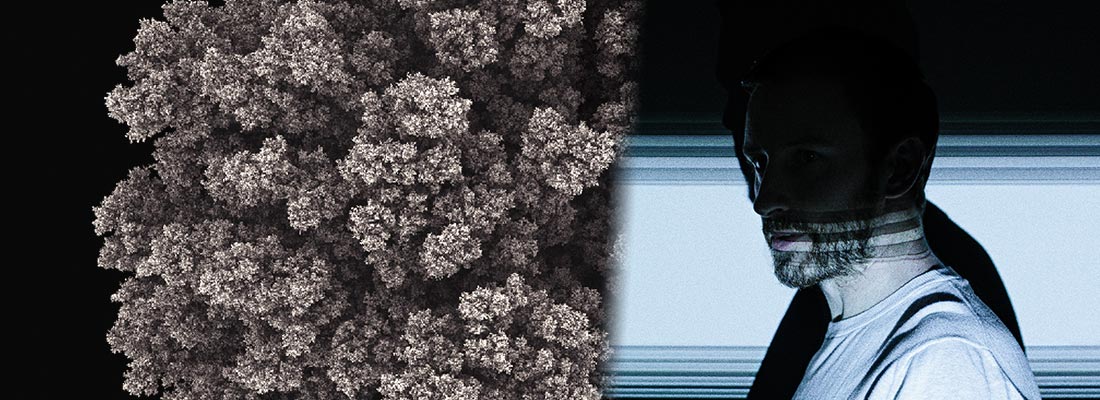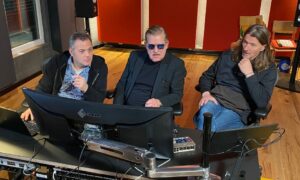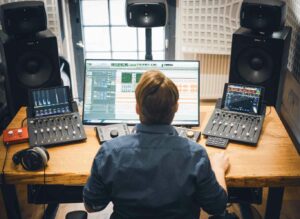
Max Cooper has re-released Emergence in Dolby Atmos. This album definitely blew us away and it is great to see an electronic audio-visual release on Pure Audio Blu-ray. As the demand for the format picks up we are seeing the expansion of the format into different genres. This is the sophomore album by electronic artist Max Cooper who has collaborated with other artists; mathematicians and even scientists to bring us this conceptual album that is the story of the creation of the universe. Specifically “the story of the development of the universe, the way in which very complex things like human beings were created from the immaterial by the action of simple laws.” Though the concept is abstract in nature a lot of its creation is derived from scientific research. Max Cooper himself has a PhD in computational biology and worked as a geneticist at UCL. We were eager to hear what Max Cooper had to say about the re-release of Emergence after listening to the album in Dolby Atmos.
...Music was a hobby that turned into a job but I started to miss my old work, so I looked for a way of bringing all my interests together, and this was it.”
Your album connects art and science in an impressive way. Do you see yourself as a creator in the role of a scientist or an artist?
“As an artist interested in natural aesthetics. Particularly the boiled down fundamentals of nature, the simplest natural laws and processes, seem to contain an aesthetic richness greater than their complexity would seem to imply – nature is built of beautiful form at all levels, not just at the human scale we can see in life etc. It’s an endless source of ideas for visual stories to which I can create musical accompaniments.”
What inspired you to bring science, music and film together in this form?
“I’m a computational biologist by training, and with a long term love of visual art and film. Music was a hobby that turned into a job but I started to miss my old work, so I looked for a way of bringing all my interests together, and this was it.”
What does ‘Emergence’ mean to you?
“Emergence is when a system built of comprehensible building blocks displays some unexpectedly rich behavior. It displays something which seems more than the sum of its parts. You are a good example of that. We can explain you in terms of particles and reactions, but you know you’re more than that. There is debate about whether emergence is more to do with our ignorance than something scientific. Perhaps if we were smarter it would be obvious that some bouncing particles should feel like they had too much to drink the night before. I like the idea that it’s a signpost for the unknown and often for beautiful things. Emergence seems to link nature to art, that’s why I chose it.”

Max Cooper | Photo: Ozge Cone
EMERGENCE has already been released on CD in 2016. Why did you re-release it in immersive audio?
“The project initially started in 2013 or so, as my first attempt bringing together science, visuals and music for live shows. It proved to be such an interesting and enjoyable process that I decided to turn the project into an album and some EPs, and it then grew into this final surround sound version. It’s such a wide ranging topic that I kept on finding more ways to explore it. Even my subsequent albums since can largely be incorporated in the Emergence story, because it’s the grand narrative of creation of everything from nature’s building blocks.”
“I have to consider each piece of music as a living 3-dimensional entity."
What new possibilities for electronic and ambient music do you see in new immersive audio formats? Are there any advantages over classic stereo sound?
“I love using spatiality as a musical tool in addition to the standard elements of rhythm, melody, harmony, dynamics and timbre. Spatiality can be just as important, but it’s often ignored as it’s not usually possible to employ it to its fullest. With systems like Dolby Atmos, sounds can dance around us and take on spatial form, smooth, jagged, calming or erratic, conveying the same sorts of messages as the traditional elements of music. The result can be a more powerfully communicated idea, and hopefully more fulfilling music.”
What attention to detail goes into creating an immersive mix and how does it affect the process of creativity?
“I have to consider each piece of music as a living 3-dimensional entity. Once I have that idea I can then place each sound and know what size it should be, how it should move etc. I try to match up this spatial form with that of the music and video, some peaceful curved immersive tracks, some chaotic jittering glitch machines, that sort of thing. It was a big job as my tracks have lots of layers of sounds, and every moment of every layer needs to be planned and implemented separately.”
You collaborated with mathematicians and scientists on EMERGENCE. How did it affect the album?
“Every collaboration involved is explained at emergence.maxcooper.net. For some of the chapters I wanted to visualise ideas like the distribution of the primes and hyperdimensional shapes with more than 3 spatial dimensions. These required some mathematics so it came out with a very stripped aesthetic. One chapter visualised real DNA structure via a simulated annealing process – long cylinders of DNA tangle and tangle to reach a best prediction of how they are folded to conform with experiments detecting points of contact (“Chromos” in collaboration with Mikhail Spivikov and researchers at the Babraham institute). While the mathematician Andy Lomas uses simulated models of cell division to emergently create beautiful biologically reminiscent forms. Each of these approaches yielded totally new aesthetics which would have been possible to achieve via traditional animation techniques. The music is scored to these aesthetics, where I try to link the musical to the visual form, so it took on its own new directions in response to these new visual ideas. Sometimes I could link things more explicitly with the music too, for example with “Order from Chaos” where I used a random rhythmical source of rain hitting a window, then gradually forced the position of each drop closer and closer to a drum grid, yielding an emergent rhythm to which the rest of the track was built around.”
You have already worked with the “4D Soundsystem” and have now released your first album in 3D-Audio. Can we expect more immersive audio productions from you in the future? Are you planning to explore more “dimensions”?
“Spatiality in sound has been one of my major interests for some time and it will continue to be so, yes. Even my normal stereo releases contain a lot of spatial work via binaural techniques, both simulated and field recorded with binaural mics inside my ears to capture how the sound interacts with the head and ears. Those subtle signals are interpreted by our brains to give the impression of spatiality when we listen back on headphones. I often use that sort of signaling to separate elements of a mix so I can cram more sounds in that I would not be able to otherwise. There’s a limit to how many different sounds we can hear separately at once, and by spatially separating sounds it seems to increase the capacity. The same thing goes for the Dolby Atmos Emergence project, it’s a nice way I can present all the micro-sounds I want and have them heard as the independent sources of recording and synthesis that they are. My newest album, “Yearning for the Infinite” (Nov. 7th ’19) pushes these boundaries and sound density even further, but I’m not satisfied yet, so yes, lots more explorations to come.”
Emergence (Dolby Atmos Edition) is now available in the shop on Pure Audio Blu-ray or Pure Audio Blu-ray + CD Album (2016). Get it here.




